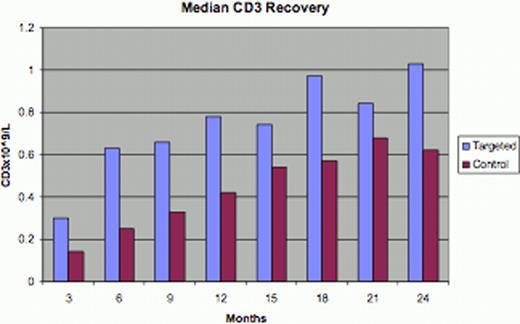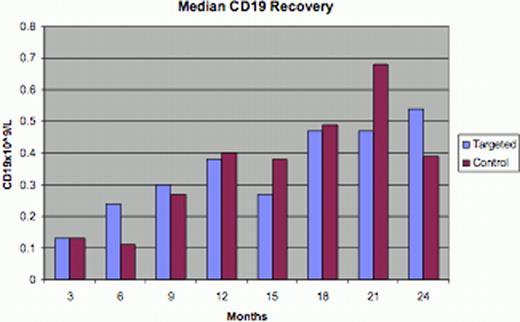Abstract
Abstract 4489
The speed of immune reconstitution post haematopoietic stem cell transplant (HSCT) is important both in terms of post transplant infectious complications and the risk of disease relapse or development of secondary malignancies. It is, therefore, important that immune reconstitution is assessed following the introduction of a new conditioning protocol.
Yttrium-90 labelled anti-CD66 has been used in our institution as part of phase I and II clinical trials in both the autologous and allogeneic setting. There is currently, to our knowledge, no published data looking at immune reconstitution post targeted radiotherapy.
19 patients in our institution have undergone allogeneic HSCT with reduced intensity conditioning and the addition of targeted radiotherapy (both sibling and volunteer unrelated donor). In 18 patients conditioning was with Fludarabine, Melphalan and Campath-1H (one Fludarabine, Cyclophosphamide and Campath-1H). The Yttrium-90 labelled anti-CD66 was shown to add a mean of 35Gy radiation dose to the bone marrow at the highest radiation dose level. 19 control patients were matched as closely as possible for conditioning chemotherapy, underlying disease, prior treatment, age and donor age.
Immune reconstitution data are routinely recorded in our institution every three months for the first two years post allogeneic stem cell transplantation. These data were retrospectively collected and analysed for all 38 patients. The p values were calculated using Mann-Whitney tests.
Patient characteristics for the two groups are shown below (Table 1).
| . | Median age (range) . | Sex (%) . | Underlying disease (%) . | ||||||
|---|---|---|---|---|---|---|---|---|---|
| M . | F . | AML . | MDS . | ALL . | CML . | MM . | WM . | ||
| Targeted radiotherapy | 55 (21–65) | 17 (89) | 2 (11) | 7 (37) | 2 (11) | 1 (5) | 3 (16) | 6 (32) | 0 (0) |
| Control | 50 (23–63) | 13 (68) | 6 (32) | 8 (42) | 3 (16) | 2 (11) | 0 (0) | 5 (26) | 1 (5) |
| . | Median age (range) . | Sex (%) . | Underlying disease (%) . | ||||||
|---|---|---|---|---|---|---|---|---|---|
| M . | F . | AML . | MDS . | ALL . | CML . | MM . | WM . | ||
| Targeted radiotherapy | 55 (21–65) | 17 (89) | 2 (11) | 7 (37) | 2 (11) | 1 (5) | 3 (16) | 6 (32) | 0 (0) |
| Control | 50 (23–63) | 13 (68) | 6 (32) | 8 (42) | 3 (16) | 2 (11) | 0 (0) | 5 (26) | 1 (5) |
There was no statistically significant difference in the engraftment data between the two groups (Table 2).
| . | Median Days to neutrophils >0.5 × 109/L (Range) . | Median days to platelets >20 × 109/L (Range) . |
|---|---|---|
| Targeted radiotherapy | 19 (12–25) | 14 (9–51) |
| Control | 18 (11–24) | 13 (10–40) |
| p value | 0.39 | 0.53 |
| . | Median Days to neutrophils >0.5 × 109/L (Range) . | Median days to platelets >20 × 109/L (Range) . |
|---|---|---|
| Targeted radiotherapy | 19 (12–25) | 14 (9–51) |
| Control | 18 (11–24) | 13 (10–40) |
| p value | 0.39 | 0.53 |
CD3+, CD4+ and CD19+ results for the two groups are shown in the graphs below:
Differences were statistically significant only for CD3+ cells at three and six months post transplant, where levels were higher in the targeted radiotherapy group (p=0.02 and p=0.01 respectively) and at six months for CD4+ cells, where levels were significantly higher in the targeted radiotherapy group (p=0.03). Beyond six months post transplantation no statistically significant difference was seen. No statistically significant difference was seen for B cells at any time point in the first two years. Mean IgG and IgM values were within normal reference ranges for both groups at all time point measured.
Donor lymphocyte infusion (DLI) may influence the rate of immunological reconstitution, therefore data regarding DLIs given in the first two years were collected. The control group received slightly more DLIs in the first two years post transplant (a mean of 4.1 compared to 2.8 in the targeted radiotherapy group, p= 0.17) with a mean total CD3+ cell dose of 5.4×106/Kg in the targeted radiotherapy group and 8.3×106/Kg in the control group, p= 0.50. Early Chimerism results (Day 30, 3 months and 6 months post transplant) were also compared, and no statistically significant differences were found.
Targeted radiotherapy has great potential for delivering significant doses of radiation to sites of disease without additional toxicity. It appears that the addition of targeted radiotherapy to a reduced intensity conditioning regimen does not adversely affect immune reconstitution post allogeneic stem cell transplantation. Larger patient numbers are required to confirm these findings.
No relevant conflicts of interest to declare.
Author notes
Asterisk with author names denotes non-ASH members.




This feature is available to Subscribers Only
Sign In or Create an Account Close Modal